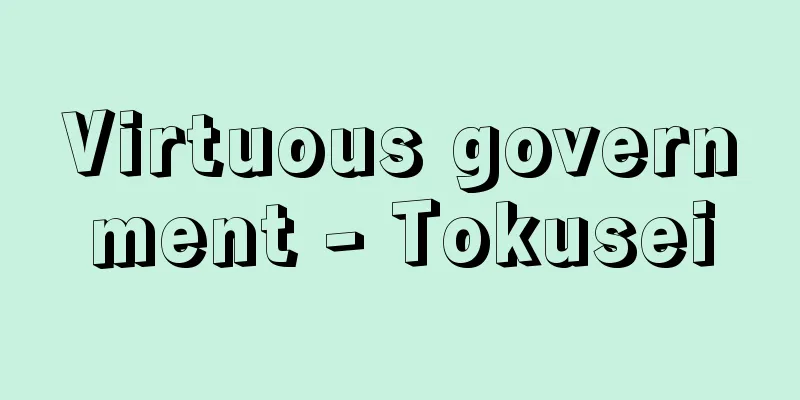Virtuous government - Tokusei

|
Originally, it meant that natural disasters and epidemics were caused by the ruler's immorality, and that in order to eliminate them, the ruler should implement measures such as amnesty, tax exemption, and debt forgiveness for the poor, in order to exercise good governance and benevolence. However, in the Middle Ages, it came to mean the invalidation and annulment of loans and purchases. [Norimi Sakai] The late Kamakura periodThis change in the meaning of tokusei was largely due to the tokusei of the nobles and samurai classes, which seemed to echo the trend in the late Kamakura period. The Kamakura shogunate issued its first tokusei decree (decree to restore lands) in 1267 (Bun'ei 4) to prevent its power base, the vassals, from losing their lands through pawning and selling, becoming "footless vassals." In 1284 (Kōan 7), the political reforms led by Adachi Yasumori also led to the integration of tokusei and decrees to restore lands. Meanwhile, the nobles around this time were also actively practicing tokusei under the Kameyama Insei, who invalidated the sale and pawning of temple and shrine lands for the purpose of holding Buddhist and Shinto ceremonies, ordering their return to their original owners. The tendency to think that tokusei meant an order to restore land became decisive when the Einin Tokusei Order was issued in 1297 (Einin 5), which allowed the shogunate to recover free of charge all land owned by samurai that had been sold or pawned by non-samurai or ordinary people. [Norimi Sakai] Private Virtue Government, Local Virtue Government and Local EstablishmentAmong the many phrases on medieval peasant sales slips, there is one that reads, "The whole of the country, as well as the uprisings of nobles and samurai, will be granted the uprising of the land." This shows that uprisings were not only granted by the Imperial Court, the Shogunate, or the shugo (military governors), but also by peasant uprisings. Regardless of whether an uprising order for uprisings was issued by public authorities, the use of force by peasant uprisings, such as storming into sake shops and peasant storehouses to tear up the promissory notes and take back the pawned property, or by local peasant alliances or villages to break off loan relationships and allow the land to be taken back, are called private uprisings or local uprisings. In addition, sales slips for the areas centered around Ise and Yamato contain the word "jiokoshi" (local development, local origin), which refers to the act of taking back land that has been sold or pawned. These examples suggest that private acts of virtuous government were widespread in medieval society. However, since these private acts of virtuous government only emerged in the later Middle Ages, it would appear that virtuous acts were first issued by public authorities such as the shogunate, and that private virtuous government was born out of this. However, recent discussions of virtuous government and local origins suggest that the opposite is true. In medieval society, there was a deep-rooted idea of the unity of land and its owner, as shown by the close ties between developed areas and developers, and even if ownership was transferred through sale or pawning, this was considered to be a "temporary state." With this idea as a background, virtuous government was carried out, the essential content of which was to restore things to their original state, i.e. to return them to their original state, i.e. to "restore" them. From this perspective, "an island of imperial and military virtue floats in a sea of private and local virtue." [Norimi Sakai] Tokusei IkkiTokusei Ikki, in which local people rise up in the name of "virtuous government", have occurred frequently since the Shocho Doikki in 1428 (Shocho 1), which began in Omi (Shiga Prefecture) and spread to Kinai and Kinki provinces, until the Sengoku period. In the Doikki of 1441 (Kakitsu 1), tens of thousands of local people from around Kyoto set up camps in 16 buildings in Kyoto, invaded Rakuchu and attacked the Dogura, and succeeded in forcing the Muromachi Shogunate to issue the "Tenka Ippon Tokuseirei" (a nationwide decree recognizing virtuous government). This movement spread to Yamato, Ise, Mikawa, and Wakasa, and in particular in Tara-sho in Wakasa Province (Fukui Prefecture), farmers were seen claiming that they should "adopt the great law of the countryside" in response to the Shogunate's Tokuseirei. After that, there were successive peasant uprisings in 1447 (Bun'an 4), 1454 (Kyōtoku 3), and 1457 (Choroku 1), during which private tokusei were actively practiced, but when the shogunate issued the "Buichi Tokuseirei" (Order of Tokusei) during the Kyōtoku peasant uprising, the goals of the peasant uprisings became unclear. Furthermore, within the so, which was the basis of the uprisings, the hierarchical division between the local lords and ordinary peasants became more pronounced, and the peasant uprisings after Choroku became less organized and solidaristic. The "Buichi Tokuseirei" (Order of Tokusei) provided that only those who paid one-tenth of their debts to the shogunate were given a letter of approval for tokusei. This meant that only the wealthy who could pay bunichi sen were legally granted tokusei, and for the peasants who could not do so, the acquisition of the Tokuseirei did not mean freedom from debt. Moreover, the shogunate was able to compensate for the reduction in soil taxes that had been caused by the Tokusei-rei (decree of amnesty) by collecting one sen per tax. However, since the rebellions that rose up in the name of "virtuous government" had as their background "a sea of private and local virtuous government," the content of the virtuous government cannot be understood as being limited to the shogunate's virtuous government edicts. The case of Taranosho in Wakasa Province, where people advocated "rural law" in response to the virtuous government edicts of the Kakitsu era, illustrates this point. Furthermore, in 1457 (Choroku 1), the people of Furu village in Yamato Province (Nara Prefecture) rose up in response to an uprising in Yamashiro Province (Kyoto Prefecture) and implemented amnesty for the village, including the abolition of unpaid taxes and the reduction of the size of the manor's boxes, which was initiated by Kofuku-ji Temple.When we look at this incident, we can see that the amnesty that the uprising sought and carried out did not simply end with the abolition of lease relationships and the recovery of the land, but also sought to solve problems that were deeply related to their daily lives, such as the abolition of unpaid taxes and the reduction of taxes by reducing the size of the boxes for collecting taxes, which were a symbol of the seizure of taxes.It also embodied a desire for "rebirth and revival of the world." [Norimi Sakai] "Studies on Legal History" by Miura Shuko (1919, Iwanami Shoten)" ▽ "Studies on Peasant Uprisings" by Nakamura Yoshiharu (1974, Azekura Shobo)" ▽ "Virtuous Government in the Muromachi Period" by Kuwayama Kozen (included in Medieval Society and Economy, 1962, University of Tokyo Press)" ▽ "A Study on the History of Medieval Japanese Law" by Kasamatsu Hiroshi (1979, University of Tokyo Press)" ▽ "Virtuous Orders" by Kasamatsu Hiroshi (Iwanami Shinsho)" ▽ "Virtuous Uprisings" by Tanaka Michiko (included in Ikki 2, 1981, University of Tokyo Press)" ▽ "A Study on the History of the Establishment of Law in the Warring States Period" by Katsumata Shizuo (1979, University of Tokyo Press) ▽ "Ikki" by Katsumata Shizuo (Iwanami Shinsho) Source: Shogakukan Encyclopedia Nipponica About Encyclopedia Nipponica Information | Legend |
|
本来は、天変地異や疫病の流行などを君主の不徳によって生ずるものとして、それを除くために大赦、免税、貧窮者の債務免除などの際だった善政、仁徳ある政治を行うことであった。しかし中世ではもっぱら貸借、売買の無効、破棄を意味するようになる。 [酒井紀美] 鎌倉後期の公武徳政徳政の意味がこのように変化する過程には、鎌倉後期に相呼応するかのように行われた公家・武家の徳政が大きくかかわっている。鎌倉幕府はその権力基盤をなす御家人(ごけにん)が質入れ、売却などによって所領を失い「無足(むそく)の御家人」となっていく動きを抑制するため、1267年(文永4)に最初の徳政令(所領回復令)を出し、さらに84年(弘安7)安達泰盛(あだちやすもり)の主導で展開された政治改革においても、徳政と所領回復令の一体化を進めることになった。一方、このころ公家のほうでも亀山(かめやま)院政によって徳政が積極的に行われ、仏神事の興行を目的として、寺社領の売却、質入れを無効とし本主への返還を命じている。徳政とはすなわち所領回復令だとする傾向は、1297年(永仁5)に幕府が非御家人、凡下(ぼんげ)に売却、質入れした御家人の所領をすべて無償で取り戻しうるとした永仁(えいにん)の徳政令を出すに至って、決定的なものとなる。 [酒井紀美] 私徳政、在地徳政と地起中世農民の売券(ばいけん)に数多くみられる徳政文言(もんごん)のうちに、「天下一同又ハ公家武家之土一器(揆)等御徳政」というのがある。これは徳政が、朝廷あるいは幕府、守護などによって行われるだけでなく、土一揆によっても行われることを示すものである。公権力による徳政令が発布されたか否かにかかわりなく、土一揆が酒屋・土倉(どそう)に押し寄せ借書を破り質物を取り戻すといった実力行使に及ぶこと、あるいは地域の土豪連合や惣村(そうそん)が貸借関係の破棄・土地の取り戻しを認めることなどを、私(し)徳政・在地徳政とよんでいる。また、伊勢(いせ)、大和(やまと)を中心とする地域の売券には、売却地や質入れ地の取り戻し行為をさす「地起(じおこし)」(地興、地発)ということばがみられる。これらは中世社会にあって私的な徳政行為が広く行われていたことをうかがわせるものである。ただ、こうした私徳政はいずれも中世の後期になって姿を現してくるので、その限りでいえば、まず幕府などの公権力の徳政令があり、それに触発される形で私徳政が生まれてきたかにみえる。 しかし、近年の徳政論や「地起」をめぐる議論によれば、逆の事態が想定される。中世社会には、開発地と開発者の密接な結び付きに示されるような「土地と本主の一体化観念」が根強く存在しており、たとえ売買や質入れによって所有が移動しても、それは「仮の姿」であるとされた。こうした観念を背景に、元に戻す=本来のあるべきところに戻す=「復活」を本質的な内容とする徳政が行われたのである。こうした観点からすれば、「私徳政、在地徳政の海の中に、公武徳政の島が浮かんでいる」ということになる。 [酒井紀美] 徳政一揆土民(どみん)が「徳政と号して」蜂起(ほうき)する徳政一揆は、1428年(正長1)近江(おうみ)(滋賀県)に始まり畿内(きない)近国へとその動きが拡大していった正長(しょうちょう)の土一揆以来、戦国時代に至るまで頻繁に起こっている。1441年(嘉吉1)の土一揆は、京都周辺の土民数万人が京都の堂舎16か所に陣取り、洛中(らくちゅう)に攻め入って土倉を襲撃し、初めて室町幕府に「天下一同徳政令」(全国的に徳政を認める)を出させることに成功した。この動きは大和、伊勢、三河、若狭(わかさ)にも及び、とくに若狭国(福井県)太良荘(たらのしょう)では幕府の徳政令に対して「田舎(いなか)の大法」を主張する農民の姿がみられる。その後も1447年(文安4)、54年(享徳3)、57年(長禄1)と相次いで土一揆の蜂起があり、そのなかで私徳政も盛んに行われるが、享徳(きょうとく)の土一揆に際して幕府が「分一(ぶいち)徳政令」を出すに及んで、土一揆の目標は不鮮明なものとなる。またその基盤となっている惣内部に、土豪層と一般百姓という階層分化を際だたせるようになり、長禄(ちょうろく)以後の土一揆は組織性、連帯性を欠いたものとなっていく。「分一徳政令」とは、債務の10分の1を幕府に納めた者に限り徳政認可の奉書を与えるというもので、これにより合法的に徳政を認められるのは分一銭を納入できる富裕層に限られ、それが不可能な土民にとって徳政令獲得は債務からの解放を意味するものではなくなってしまう。しかも幕府は、徳政令によって減少した土倉役を、分一銭収取によって補填(ほてん)しうることになるのである。 しかし、「徳政と号して」蜂起した一揆が「私徳政、在地徳政の海」を背景にもつ以上、その徳政の内容を幕府の徳政令に限定してとらえることはできない。嘉吉(かきつ)の徳政令に対し「田舎の大法」を主張した若狭国太良荘の事例は、それを物語るものである。また1457年(長禄1)大和国(奈良県)布留(ふる)郷の郷民が山城(やましろ)国(京都府)の一揆に呼応して立ち上がり、布留郷に徳政を実施し、未進年貢の破棄、荘の桝(ます)を小さくする行為に及んだため、興福寺の発向を受けた事件などをみると、一揆が求め、そして実行した徳政の内容は、単に貸借関係の破棄や土地取り返しにとどまらず、未進年貢の破棄や、年貢収奪の象徴ともいえる収納桝を小さくし年貢の減免を図るといった、彼らの日々の生活に深くかかわる問題の解決を図ろうとするもので、さらに「世の生まれかわり」、再生を求める意識をも内包していたのである。 [酒井紀美] 『三浦周行著『法制史の研究』(1919・岩波書店)』▽『中村吉治著『土一揆研究』(1974・校倉書房)』▽『桑山浩然著『室町時代の徳政』(『中世の社会と経済』所収・1962・東京大学出版会)』▽『笠松宏至著『日本中世法史論』(1979・東京大学出版会)』▽『笠松宏至著『徳政令』(岩波新書)』▽『田中倫子著『徳政一揆』(『一揆2』所収・1981・東京大学出版会)』▽『勝俣鎮夫著『戦国法成立史論』(1979・東京大学出版会)』▽『勝俣鎮夫著『一揆』(岩波新書)』 出典 小学館 日本大百科全書(ニッポニカ)日本大百科全書(ニッポニカ)について 情報 | 凡例 |
<<: Tokusei Ikki - Tokusei Ikki
>>: Reading History Notes - Tokushiyoron
Recommend
Japanese lily - Japanese lily
A perennial plant of the Rosaceae family that grow...
Disciform macular degeneration
In these conditions, vision is significantly impa...
Blakemore, AH (English spelling) BlakemoreAH
...Artificial blood vessels used as materials for...
Ludwig I (King of Bavaria)
…She was born in Ireland as the daughter of a Bri...
punaluan marriage (English)
…At the same time, Morgan believed that kinship n...
Sea urchin - Sea urchin
…It is used as bait for fishing for sea bream, fl...
Neoscona fuscocalorata (English spelling)
… [Eiichi Shinkai]. … *Some of the terminology th...
Musazi, IK (English spelling) MusaziIK
… In 1949, after the Second World War, popular ri...
Nevus of Ota, Ota Nevus
[What kind of disease is it?] Ota nevus is a brown...
The tenth place
[1] (Noun) ① A Buddhist term. A classification of ...
Boar lice - Boar lice
...Hosts are animals of the even-toed ungulate fa...
Visitor - Yoryudo
(1) From the Heian to Muromachi periods, the name...
Roosevelt
American politician. Also known as Roosevelt. 32nd...
Hovenia tomentella (English spelling) Hovenia tomentella
… [Okamoto Motoji]. … *Some of the terminology th...
angelfish
...They are docile except during the breeding sea...








![Mima [town] - Mima](/upload/images/67ccf5961e47c.webp)
